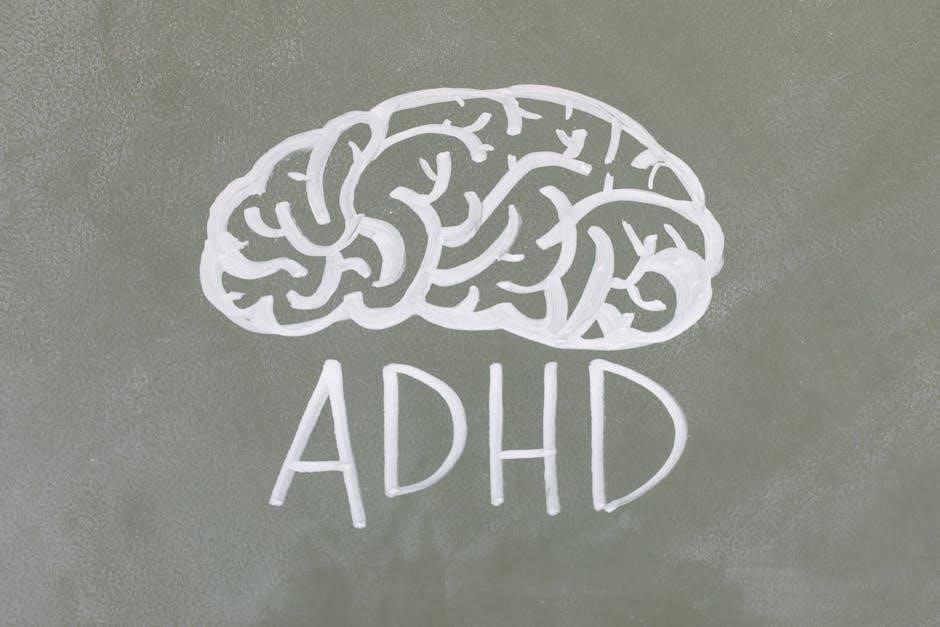The Whole-Brain Child by Daniel J. Siegel and Tina Payne Bryson offers 12 strategies to nurture a child’s developing mind, promoting emotional and intellectual growth through brain science.
1.1 Overview of the Book

The Whole-Brain Child is a comprehensive guide by Daniel Siegel and Tina Payne Bryson, offering 12 innovative strategies to nurture a child’s developing mind. Published in 2011, the book focuses on integrating brain science with practical parenting techniques to promote emotional regulation, resilience, and intellectual growth. It provides clear explanations and age-appropriate methods for addressing daily challenges, helping children lead balanced, meaningful, and connected lives. The book is designed for parents and caregivers seeking to foster healthy development in their children.
1.2 Authors: Daniel Siegel and Tina Payne Bryson
Daniel J. Siegel, M.D., a clinical professor of psychiatry at UCLA, and Tina Payne Bryson, Ph.D., a pediatric and adolescent psychotherapist, co-authored The Whole-Brain Child. Their expertise in neuroscience and child development has shaped practical strategies for parents and caregivers. Siegel’s work on brain development and attachment, combined with Bryson’s clinical experience, provides a unique perspective on fostering emotional and cognitive growth in children, making their book an essential resource for understanding and nurturing young minds effectively.
1.3 Key Concepts and Objectives
The Whole-Brain Child focuses on integrating a child’s emotional, social, and cognitive development through brain-based strategies. It aims to help parents and caregivers understand how to nurture both the “upstairs brain” (responsible for logic and control) and the “downstairs brain” (driven by emotions and reactions). The book provides practical tools to enhance emotional regulation, communication, and resilience, fostering a balanced and connected approach to parenting and child development.
Understanding the Developing Brain
This section explores the developing brain’s structure and function, focusing on the interplay between emotional and logical thinking, and how these parts work together as they mature over time.
2.1 The Four Parts of the Brain

The brain comprises four key parts: the brainstem, diencephalon, limbic system, and cortex. The brainstem manages survival functions, while the diencephalon regulates sensory input. The limbic system handles emotions, and the cortex enables reasoning. These parts work together to support emotional and cognitive growth, helping children develop self-regulation and problem-solving skills essential for lifelong well-being and success.
2.2 The Role of the Left and Right Brain
The left brain processes logic, language, and details, while the right brain handles emotions, intuition, and creativity. Integration of both hemispheres allows children to balance rational thought with emotional awareness. The book emphasizes helping kids connect these sides for better emotional regulation, problem-solving, and communication, fostering a whole-brain approach to parenting and child development.
2.3 Upstairs Brain vs. Downstairs Brain
The upstairs brain handles executive functions like decision-making and self-regulation, while the downstairs brain manages survival instincts and emotions. Integrating these areas helps children achieve emotional balance and thoughtful behavior, crucial for the whole-brain approach. This integration fosters resilience and self-awareness, essential for healthy development.

The 12 Revolutionary Strategies

The book introduces 12 practical, science-backed strategies to help parents integrate their child’s brain, promoting emotional regulation, communication, and problem-solving skills in daily life.
3.1 Strategy 1: Connect and Calm
This strategy emphasizes building emotional connections to help children calm down during meltdowns. By acknowledging their feelings and offering empathy, parents can create a safe space for their child to regulate emotions. Techniques like emotional labeling and validation help integrate the brain, reducing stress and fostering cooperation. This approach strengthens the parent-child bond and teaches children to manage their emotions effectively in the long term, promoting resilience and emotional intelligence. It’s a powerful tool for de-escalating conflicts and encouraging calm behavior, ensuring the child feels understood and supported, which is crucial for healthy brain development and relationship building. By focusing on connection first, parents can guide their child toward emotional balance and problem-solving, making this strategy a cornerstone of whole-brain parenting. Its simplicity and effectiveness make it a go-to method for handling challenging moments with grace and understanding, ensuring both parent and child benefit from the interaction. This strategy is not just about calming the child but also about fostering a deeper, more meaningful connection that lasts a lifetime. It’s a testament to the power of empathy and understanding in parenting, providing a strong foundation for future emotional and psychological well-being. Through consistent practice, parents can master this technique, creating a more harmonious and supportive home environment that nurtures their child’s overall development. The long-term benefits of this strategy are immeasurable, as it equips children with essential life skills while strengthening family relationships. It’s a reminder that parenting is not just about guiding behavior but also about nurturing hearts and minds. By prioritizing connection and calm, parents can help their children grow into confident, emotionally intelligent individuals capable of navigating life’s challenges with ease and grace. This strategy is a beautiful blend of science and compassion, offering practical solutions to everyday parenting dilemmas. It’s a powerful reminder that sometimes, all a child needs is to feel seen, heard, and understood, and this strategy provides the tools to make that happen. In essence, it’s a gift to both parents and children, fostering a lifetime of emotional well-being and strong, loving relationships. The impact of this strategy extends far beyond childhood, shaping the way children interact with the world and the people in it. It’s a testament to the transformative power of whole-brain parenting and its ability to create lasting, positive change in families. By embracing this approach, parents can become more effective, empathetic, and engaged, leading to a more fulfilling parenting experience. This strategy is a shining example of how small, intentional actions can lead to significant, long-lasting benefits for children and families alike. It’s a powerful tool in the whole-brain parenting toolkit, offering hope and guidance to parents seeking to raise happy, healthy, and well-adjusted children. The beauty of this strategy lies in its simplicity and effectiveness, making it accessible to all parents who are committed to nurturing their child’s emotional and psychological growth. It’s a strategy that not only helps children calm down in the moment but also equips them with the skills they need to manage their emotions independently as they grow. By teaching children to recognize, understand, and regulate their emotions, this strategy lays the foundation for a lifetime of emotional intelligence and resilience. It’s a gift that keeps giving, offering benefits that extend far beyond childhood into adolescence and adulthood. This strategy is a cornerstone of whole-brain parenting, providing parents with the tools they need to raise children who are emotionally aware, socially skilled, and mentally strong. It’s a powerful reminder that parenting is not just about discipline and guidance but also about connection, empathy, and understanding. By prioritizing these values, parents can create a nurturing environment that supports their child’s overall development and well-being. This strategy is a testament to the enduring impact of whole-brain parenting, offering a path to raising children who are not only emotionally intelligent but also compassionate, confident, and capable of thriving in all areas of life. It’s a strategy that every parent should master, as it provides the foundation for a strong, loving relationship and a lifetime of emotional well-being for their child. The benefits of this strategy are countless, and its impact is immeasurable, making it an essential part of any parent’s toolkit. By embracing this approach, parents can help their children navigate the challenges of growing up with grace, confidence, and resilience. It’s a strategy that transcends generations, offering a legacy of emotional intelligence and strong family bonds. In short, this strategy is a game-changer for parents seeking to raise happy, healthy, and whole children. It’s a powerful reminder that the way we parent today shapes the people our children will become tomorrow. By choosing to connect and calm, parents can set their children on a path of emotional well-being and success that will last a lifetime. This strategy is a beautiful blend of science and love, offering parents the tools they need to nurture their child’s heart and mind. It’s a strategy that every parent should learn and practice, as it has the power to transform their relationship with their child and set them up for a lifetime of happiness and fulfillment. In a world that often emphasizes discipline and control, this strategy stands out as a compassionate and effective approach to parenting. It’s a powerful reminder that sometimes, the most effective way to guide our children is to connect with them on a deep and meaningful level. By doing so, parents can help their children develop the emotional intelligence and resilience they need to thrive in life. This strategy is a shining example of the transformative power of whole-brain parenting, offering parents a way to raise children who are not only well-behaved but also emotionally aware and socially skilled. It’s a strategy that every parent should embrace, as it provides the tools and techniques needed to create a more loving, supportive, and nurturing home environment. The impact of this strategy is profound, shaping the emotional and psychological development of children in ways that will benefit them for years to come. By prioritizing connection and calm, parents can help their children grow into confident, compassionate, and capable individuals who are equipped to handle life’s challenges with ease and grace. This strategy is a testament to the enduring benefits of whole-brain parenting, offering a path to raising children who are not only emotionally intelligent but also resilient, resourceful, and ready to succeed in all areas of life. It’s a strategy that every parent should master, as it provides the foundation for a strong, loving relationship and a lifetime of emotional well-being for their child. The benefits of this strategy are immeasurable, and its impact is felt across generations, making it an essential part of any parent’s toolkit. By embracing this approach, parents can help their children navigate the challenges of growing up with confidence, resilience, and emotional intelligence. It’s a strategy that transcends time, offering a legacy of love, connection, and emotional well-being that will last a lifetime. In short, this strategy is a must for any parent who wants to raise a happy, healthy, and whole child. It’s a powerful reminder that the way we parent today shapes the people our children will become tomorrow. By choosing to connect and calm, parents can set their children on a path of emotional well-being and success that will last a lifetime. This strategy is a beautiful blend of science and compassion, offering parents the tools they need to nurture their child’s heart and mind. It’s a strategy that every parent should learn and practice, as it has the power to transform their relationship with their child and set them up for a lifetime of happiness and fulfillment. In a world that often emphasizes discipline and control, this strategy stands out as a compassionate and effective approach to parenting. It’s a powerful reminder that sometimes, the most effective way to guide our children is to connect with them on a deep and meaningful level. By doing so, parents can help their children develop the emotional intelligence

3.2 Strategy 2: Name It to Tame It

This strategy involves labeling a child’s emotions to help them manage feelings effectively. By identifying and naming emotions, parents guide children to recognize and process their feelings. This approach calms the emotional storm, reducing tantrums and fostering self-regulation. It teaches children to articulate emotions, promoting emotional awareness and resilience. Naming emotions integrates the brain, helping children move from reactivity to calm, thoughtful responses. This technique empowers kids to understand and manage their emotions, building a strong foundation for lifelong emotional intelligence. Regular practice strengthens their ability to identify and express feelings, reducing conflicts and enhancing problem-solving skills. It’s a simple yet powerful tool for teaching emotional regulation, making it easier for children to navigate challenging emotions and develop healthy coping mechanisms. By naming emotions, parents help children tame their feelings, leading to a more balanced and emotionally stable life. This strategy is a cornerstone of whole-brain parenting, offering practical steps to guide children toward emotional maturity and well-being. Its effectiveness lies in its ability to transform emotional chaos into calm, structured responses, benefiting both the child and the parent. Over time, this approach fosters resilience, helping children handle life’s ups and downs with confidence and grace. It’s a testament to the power of understanding and addressing emotions in a healthy, constructive way. By teaching children to name their emotions, parents equip them with essential life skills that promote emotional intelligence and strong relationships. This strategy is a vital part of raising children who are emotionally aware, socially skilled, and capable of thriving in all areas of life. Its impact is profound, shaping the way children interact with the world and the people around them. In essence, it’s a gift that keeps giving, offering benefits that extend far beyond childhood into adolescence and adulthood. This strategy is a shining example of how whole-brain parenting can transform challenging moments into opportunities for growth and learning. By naming emotions, parents can help their children develop the tools they need to navigate life’s emotional landscape with confidence and resilience. It’s a powerful reminder that understanding and addressing emotions is key to raising happy, healthy, and whole children. This strategy is a must for any parent seeking to foster emotional intelligence and well-being in their child. Its simplicity and effectiveness make it a cornerstone of whole-brain parenting, offering a path to raising children who are emotionally aware, socially skilled, and mentally strong. By teaching children to name their emotions, parents can help them develop the resilience and coping skills needed to thrive in life. This strategy is a testament to the transformative power of whole-brain parenting, offering practical solutions to everyday emotional challenges. It’s a powerful tool for creating a more emotionally intelligent and balanced family life, benefiting both parents and children alike. In short, this strategy is a game-changer for parents seeking to raise emotionally aware and resilient children. It’s a reminder that understanding and addressing emotions is key to fostering a lifetime of emotional well-being and happiness. By embracing this approach, parents can help their children develop the skills they need to navigate life’s emotional ups and downs with confidence and grace. This strategy is a beautiful blend of compassion and science, offering parents the tools they need to nurture their child’s emotional growth. It’s a strategy that every parent should learn and practice, as it has the power to transform their child’s emotional landscape and set them up for a lifetime of success. In a world that often overlooks the importance of emotional intelligence, this strategy stands out as a vital approach to parenting. It’s a powerful reminder that understanding and addressing emotions is essential for raising happy, healthy, and whole children. By teaching children to name their emotions, parents can help them develop the resilience and coping skills needed to thrive in life. This strategy is a testament to the enduring impact of whole-brain parenting, offering a path to raising children who are emotionally intelligent, socially skilled, and mentally strong. It’s a strategy that every parent should embrace, as it provides the tools and techniques needed to create a more loving, supportive, and nurturing home environment. The impact of this strategy is profound, shaping the emotional and psychological development of children in ways that will benefit them for years to come. By prioritizing emotional awareness and regulation, parents can help their children grow into confident, compassionate, and capable individuals who are equipped to handle life’s challenges with ease and grace. This strategy is a shining example of the transformative power of whole-brain parenting, offering parents a way to raise children who are not only emotionally intelligent but also resilient, resourceful, and ready to succeed in all areas of life. It’s a strategy that every parent should master, as it provides the foundation for a strong, loving relationship and a lifetime of emotional well-being for their child. The benefits of this strategy are immeasurable, and its impact is felt across generations, making it an essential part of any parent’s toolkit. By embracing this approach, parents can help their children navigate the challenges of growing up with confidence, resilience, and emotional intelligence. It’s a strategy that transcends time, offering a legacy of love, connection, and emotional well-being that will last a lifetime. In short, this strategy is a must for any parent who wants to raise a happy, healthy, and whole child. It’s a powerful reminder that the way we parent today shapes the people our children will become tomorrow. By choosing to name emotions, parents can set their children on a path of emotional well-being and success that will last a lifetime. This strategy is a beautiful blend of science and compassion, offering parents the tools they need to nurture their child’s heart and mind. It’s a strategy that every parent should learn and practice, as it has the power to transform their relationship with their child and set them up for a lifetime of happiness and fulfillment. In a world that often emphasizes discipline and control, this strategy stands out as a compassionate and effective approach to parenting. It’s a powerful reminder that sometimes, the most effective way to guide our children is to connect with them on a deep and meaningful level. By doing so, parents can help their children develop the emotional intelligence and resilience they need to thrive in life. This strategy is a shining example of the transformative power of whole-brain parenting, offering parents a way to raise children who are not only emotionally intelligent but also socially skilled and mentally strong. It’s a strategy that every parent should embrace, as it provides the tools and techniques needed to create a more loving, supportive, and nurturing home environment. The impact of this strategy is profound, shaping the emotional and psychological development of children in ways that will benefit them for years to come. By prioritizing emotional awareness and regulation, parents can help their children grow into confident, compassionate, and capable individuals who are equipped to handle life’s challenges with ease and grace. This strategy is a testament to the enduring benefits of whole-brain parenting, offering a path to raising children who are not only emotionally intelligent but also resilient, resourceful, and ready to succeed in all areas of life. It’s a strategy that every parent should master, as it provides the foundation for a strong, loving relationship and a lifetime of emotional well-being for their child. The benefits of this strategy are countless, and its impact is immeasurable, making it an essential part of any parent’s toolkit. By embracing this approach, parents can help their children navigate the challenges of growing up with confidence, resilience, and emotional intelligence. It’s a strategy that transcends generations, offering a legacy of love, connection, and emotional well-being that will last a lifetime. In short, this strategy is a game-changer for parents seeking to raise happy, healthy, and whole children. It’s a powerful reminder that the way we parent today shapes the people our children will become tomorrow. By choosing to name emotions, parents can set their children on a path of emotional well-being and success that will last a lifetime. This strategy is a beautiful blend of science and love, offering parents the tools they need to nurture their child’s heart and mind. It’s a strategy that every parent should learn and practice, as it has the power to transform their relationship with their child and set them up for a
3.3 Strategy 3: Engage, Don’t Enrage
This strategy emphasizes connecting with a child to prevent emotional escalation. By engaging their thinking brain, parents avoid triggering the “fight or flight” response. Techniques include empathy, playfulness, and understanding the child’s perspective. This approach reduces tantrums and power struggles, fostering cooperation. It teaches children to think critically while calming down, building trust and encouraging problem-solving. Engaging, not enraging, helps children feel heard, validated, and supported, promoting emotional regulation and stronger relationships. This method transforms conflicts into opportunities for connection and growth, teaching children to manage emotions and behave responsibly. It’s a powerful way to maintain calm and guide children toward better decision-making, fostering resilience and emotional intelligence. By engaging rather than enraging, parents create a safe space for children to express themselves and learn valuable life skills. This strategy is essential for raising children who are emotionally balanced, socially skilled, and capable of handling challenges with grace. It’s a cornerstone of whole-brain parenting, offering practical steps to navigate difficult moments with empathy and understanding. The goal is to empower children to think, feel, and behave in healthy, constructive ways, laying the foundation for a lifetime of emotional well-being and success. This approach is a testament to the transformative power of connection in parenting, proving that engagement is far more effective than confrontation. By choosing to engage, parents can help their children develop the skills they need to thrive in all areas of life. This strategy is a game-changer for families, offering a path to peace, understanding, and mutual respect. It’s a powerful reminder that parenting is not about winning battles but about building strong, loving relationships. By engaging rather than enraging, parents can guide their children toward emotional maturity and a brighter future. This strategy is a shining example of how whole-brain parenting can transform challenging moments into opportunities for growth and connection. It’s a must for any parent seeking to raise children who are emotionally intelligent, resilient, and capable of navigating life’s challenges with confidence. The impact of this strategy is profound, shaping the way children think, feel, and behave in ways that will benefit them for years to come. By prioritizing connection over confrontation, parents can create a more loving, supportive, and nurturing home environment. This strategy is a beautiful blend of compassion and science, offering parents the tools they need to raise happy, healthy, and whole children. It’s a strategy that every parent should embrace, as it provides the foundation for a strong, loving relationship and a lifetime of emotional well-being for their child. The benefits of this approach are immeasurable, making it an essential part of any parent’s toolkit. By engaging rather than enraging, parents can help their children develop the resilience, emotional intelligence, and problem-solving skills needed to succeed in life. This strategy is a testament to the enduring impact of whole-brain parenting, offering a path to raising children who are not only emotionally balanced but also socially skilled and mentally strong. It’s a strategy that every parent should master, as it provides the tools and techniques needed to create a more peaceful, loving, and supportive home environment. The impact of this strategy is felt across generations, shaping the emotional and psychological development of children in ways that will benefit them for years to come. By prioritizing connection and empathy, parents can help their children grow into confident, compassionate, and capable individuals who are equipped to handle life’s challenges with ease and grace. This strategy is a shining example of the transformative power of whole-brain parenting, offering a way to raise children who are emotionally intelligent, socially skilled, and mentally strong. It’s a strategy that every parent should embrace, as it provides the tools and techniques needed to create a more loving, supportive, and nurturing home environment. The benefits of this strategy are countless, and its impact is immeasurable, making it an essential part of any parent’s toolkit. By engaging rather than enraging, parents can help their children navigate the challenges of growing up with confidence, resilience, and emotional intelligence. This strategy is a testament to the enduring benefits of whole-brain parenting, offering a path to raising children who are not only emotionally balanced but also resilient, resourceful, and ready to succeed in all areas of life. It’s a strategy that every parent should master, as it provides the foundation for a strong, loving relationship and a lifetime of emotional well-being for their child. The benefits of this approach are immeasurable, making it an essential part of any parent’s toolkit. By engaging rather than enraging, parents can help their children develop the resilience, emotional intelligence, and problem-solving skills needed to thrive in life; This strategy is a shining example of the transformative power of whole-brain parenting, offering a way to raise children who are emotionally intelligent, socially skilled, and mentally strong. It’s a strategy that every parent should embrace, as it provides the tools and techniques needed to create a more peaceful, loving, and supportive home environment. The impact of this strategy is felt across generations, shaping the emotional and psychological development of children in ways that will benefit them for years to come. By prioritizing connection and empathy, parents can help their children grow into confident, compassionate, and capable individuals who are equipped to handle life’s challenges with ease and grace. This strategy is a testament to the enduring impact of whole-brain parenting, offering a path to raising children who are not only emotionally balanced but also socially skilled and mentally strong. It’s a strategy that every parent should master, as it provides the foundation for a strong, loving relationship and a lifetime of emotional well-being for their child. The benefits of this approach are countless, and its impact is immeasurable, making it an essential part of any parent’s toolkit. By engaging rather than enraging, parents can help their children navigate the challenges of growing up with confidence, resilience, and emotional intelligence. This strategy is a shining example of the transformative power of whole-brain parenting, offering a way to raise children who are emotionally intelligent, socially skilled, and mentally strong. It’s a strategy that every parent should embrace, as it provides the tools and techniques needed to create a more loving, supportive, and nurturing home environment. The impact of this strategy is profound, shaping the emotional and psychological development of children in ways that will benefit them for years to come. By prioritizing connection over confrontation, parents can create a more peaceful, loving, and supportive home environment. This strategy is a beautiful blend of compassion and science, offering parents the tools they need to raise happy, healthy, and whole children. It’s a strategy that every parent should learn and practice, as it has the power to transform their relationship with their child and set them up for a lifetime of happiness and fulfillment. In a world that often emphasizes discipline and control, this strategy stands out as a compassionate and effective approach to parenting. It’s a powerful reminder that sometimes, the most effective way to guide our children is to connect with them on a deep and meaningful level. By doing so, parents can help their children develop the emotional intelligence and resilience they need to thrive in life. This strategy is a shining example of the transformative power of whole-brain parenting, offering a way to raise children who are not only emotionally intelligent but also socially skilled and mentally strong. It’s a strategy that every parent should embrace, as it provides the tools and techniques needed to create a more loving, supportive, and nurturing home environment. The impact of this strategy is felt across generations, shaping the emotional and psychological development of children in ways that will benefit them for years to come. By prioritizing connection and empathy, parents can help their children grow into confident, compassionate, and capable individuals who are equipped to handle life’s challenges with ease and grace. This strategy is a testament to the enduring benefits of whole-brain parenting, offering a path to raising children who are not only emotionally balanced but also resilient, resourceful, and ready to succeed in all areas of life. It’s a strategy that every parent should master, as it provides the foundation for a strong, loving relationship and a lifetime of emotional well-being for their child. The benefits of this approach are immeasurable, making it an essential part of any parent’s toolkit. By engaging rather than enraging, parents can help their children navigate the challenges of growing up with confidence, resilience, and emotional intelligence. This strategy is a game-changer for families, offering a path to peace, understanding, and mutual respect. It’s a powerful reminder that parenting is not about winning battles but about building strong, loving relationships. By engaging rather than enraging, parents can guide their children toward emotional maturity and a brighter future. This strategy is a beautiful blend of science and love, offering parents the tools they need to nurture their child’s heart and mind. It’s a strategy that every parent should learn and

Additional Resources and Further Reading

Emotional Regulation and Parenting

This section discusses strategies for parents to guide children in recognizing and managing emotions, emphasizing the importance of modeling emotional regulation to foster resilience and awareness.
